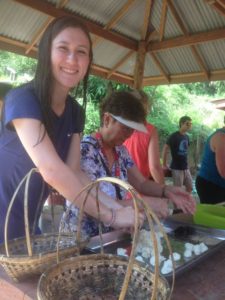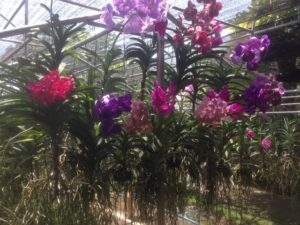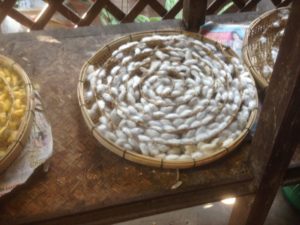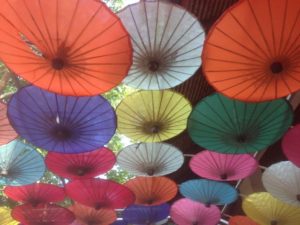Today, we visited the Elephant Care Farm up in the mountains. Again, we boarded trucks to take us into the facility. I had reservations about this trip because I don’t want the animals to be exploited. However, this facility takes care of wounded animals that have been sent to it (for example, one elephant that lost part of a foot by stepping on a land mine in Myanmar). It also takes care of elephants that have been retired from the logging business. The forests are now closed for logging, but the elephants still need to be cared for. They eat 10% of their weight each day and drink 150 liters of water. About 1/2 of Thailand’s 7,000 elephants live in the jungle and the other half have been domesticated and must continue to be cared for. In the dry season there is not enough food and water for wild elephants and many raid people’s crops. The government has to airlift in food and water for them.
This facility has 79 elephants, but we interacted with only 5 of them. We learned each elephant’s nam e. Baby Doi (5 yrs old)was a real show-off. We learned the differences between Asian and African elephants (larger head, smaller ears, 5 front toes, 4 back toes, and only male have tusks). Females carry a baby for almost 2 years, and they will not have a second baby until the first has left (3-10 years). They generally don’t have more than 4 babies in a lifetime. The average life expectancy for wild elephants is 60 years vs 80 for domesticated ones. Their oldest elephant is 93. Each elephant has a mahout or trainer/mother.
e. Baby Doi (5 yrs old)was a real show-off. We learned the differences between Asian and African elephants (larger head, smaller ears, 5 front toes, 4 back toes, and only male have tusks). Females carry a baby for almost 2 years, and they will not have a second baby until the first has left (3-10 years). They generally don’t have more than 4 babies in a lifetime. The average life expectancy for wild elephants is 60 years vs 80 for domesticated ones. Their oldest elephant is 93. Each elephant has a mahout or trainer/mother.
The mahout demonstrated how to climb on an elephant.
We also learned the commands for go (bye), move left or right (ben with knee pressure), and stop (how).
Jordan, Brooke, and JP were the first to ride.
The baby loved to give kisses.
After that, we got to wash the elephants in the river. They need to wash several times a day.
The elephants returned the favor by spraying us.
Then we prepared food for them. One mixture was tamarind, brown sugar, salt, and herbs. Another was sticky rice with brown sugar, salt, and herbs.  The boys claimed to be top chefs.
The boys claimed to be top chefs.
We also fed them bananas and sugar cane. The elephants take food with their trunks, but if you say “bon,” they will open their mouths and you can stick food on their tongue. One of the elephants spotted the bunch of bananas I had set down and snatched the whole thing up and ate it in one go.
After the feeding, we got to take pictures with the elephants. Brooke seemed to have a particular affinity for the male elephant and he for her.
They all got elephant kisses from the baby. We all fell in love with the elephants and agreed that interacting with them was an exceptional experience. 

The elephants were only too willing to accept our tips and then hand them to their mahouts. The baby would bow and swing his trunk around. He was clearly the rock star.
We were sad to leave the elephants behind, but next we went to an orchid and butterfly farm for lunch. 
After a two hour break at the hotel, we loaded up again and headed out to see a silk factory, where we saw the life cycle of the silk worm as it eats mulberry leaves and then spins a cocoon (white and yellow).
and then spins a cocoon (white and yellow).
We then saw how they boiled the cocoons and drew the silk from the cocoons into thread.
The thread is dyed with natural colors.
The spinning is done by hand (pots of dye in front).
For patterns, the thread is counted and rolled out, then woven by hand.
thread is counted and rolled out, then woven by hand.
Only one loom had the shuttle automated (somewhat.)
Next, we went to the parasol factory, where they make their own paper and bamboo frames.
The parasols are hand painted. Only two artists were left by the time we arrived, but I had a dragon painted on the back of my phone.

Next, we went to a home-hosted dinner at a home made entirely of teak.
Our host showed us how to make appetizers from a paan leaf that we filled with ginger, onion, fried tofu, peanuts, brown sugar syrup and coconut. They were delicious. Our host then showed us how to make green curry and prepared gifts of curry paste and a recipe for u to take home with us.
The meal was served in dishes set a dugout canoe. It was the best meal we have had so far, and we have had some great ones. Our host owns a restaurant and beer garden (2,000 seats, 4 bands, and 20 food trucks). After dinner, he gave us a tour of the house, which was several single-family houses incorporated into one. He showed us the Buddha room where the family puts, not just religious icons, but photos and items of significance to the family. It was a lovely glimpse into a family’s life and we were grateful the family chose to share it with us.








